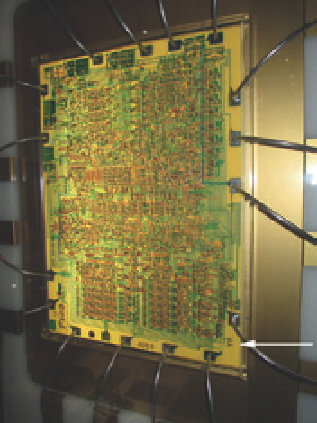Information Technology Reference
In-Depth Information
In 1965, Moore (
B.7.10
) wrote an article for the thirty-fifth anniversary
issue of
Electronics
magazine entitled “Cramming More Components onto
Integrated Circuits,” in which he noted that the complexity of ICs had been
doubling every year since 1962. He made the bold prediction that this rate of
progress would continue for another decade (
Fig. 7.15a
), and he speculated
that the eventual impact of such chips would be enormous, not only for indus-
try but also for individual consumers: “Integrated circuits will lead to such
wonders as home computers - or at least terminals connected to a central
computer - automatic controls for automobiles, or portable communications
equipment.”
10
Moore made his predictions more than a decade before Steve Jobs and
Stephen Wozniak produced the first mass-market personal computer and six-
teen years before the appearance of the IBM PC. Caltech engineering profes-
sor Carver Mead (
B.7.11
) dubbed Gordon Moore's prediction
Moore's law
, but
it took a long time for Moore to get used to using the name! In 1975, Moore
updated his law by suggesting that a doubling of the complexity of ICs every
two years was more realistic. Nowadays, Moore's law is usually stated as a dou-
bling of the number of transistors on a chip every eighteen to twenty-four
months. This rapid, year-on-year decrease in size of transistors and the corre-
sponding increase in complexity have continued for more than thirty-five years
(
Fig. 7.15b
). Moore reviewed the status of his law again in 1995, at a time when
the Intel Pentium microprocessor contained nearly five million transistors. His
conclusion was: “The current prediction is that this is not going to stop soon.”
11
Today, nearly fifty years after his initial prediction, there are now devices with
more than one billion transistors.
The doubling of complexity embodied in Moore's law occurs primarily
because each generation of semiconductor fabrication facility decreases the
minimum feature size on the chip so that the individual transistors can be
made smaller. What was not clear in 1965 when Moore made his prediction
was whether
quantum tunneling
would prove to be a major limitation on how
small the transistors could be made. Quantum tunneling is the process in quan-
tum mechanics in which a quantum particle can tunnel through a barrier in
a way that would be impossible for a classical particle. Moore asked Carver
Mead at Caltech for advice on this problem. The results of Mead's investigation
were stunning. This is how Mead described the first public presentation of the
results of his analysis:
Fig. 7.14. The Intel 4004 microproces-
sor with Frederico Faggin's initials. This
giant model with a 128× magnification is
on display at the Intel Museum.
B.7.10. Gordon Moore with Robert Noyce. Moore has a BSc degree in chemistry from UC Berkeley
and a PhD from Caltech. He joined Shockley Semiconductor Laboratory in California in 1956
before leaving to found Fairchild Semiconductor Corporation as one of Shockley's Traitorous
Eight. He and cotraitor Noyce later left Fairchild to create Intel in 1968. Moore is probably best
known for his observation, originally made in 1965, that the number of transistors on ICs would
continue to double every year. Although this increase has slowed to a doubling in eighteen to
twenty-four months, Moore's law has held true for nearly fifty years and is the foundation of the
astounding IT revolution we see around us.


Search WWH ::

Custom Search